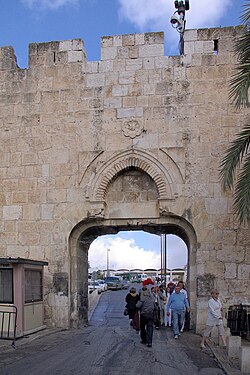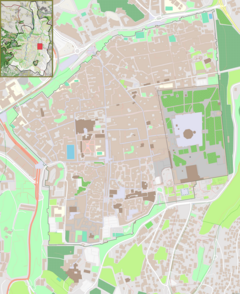| Revision as of 09:45, 25 April 2023 editEagleash (talk | contribs)Extended confirmed users108,991 edits horizontal tab ref error msg← Previous edit | Revision as of 13:06, 25 April 2023 edit undoM.Bitton (talk | contribs)Extended confirmed users54,739 edits addressed the obvious mistranslations that were introduced by Singjunun (talk)Next edit → | ||
| Line 39: | Line 39: | ||
| == The builder == | == The builder == | ||
| This gate was built after the establishment of the |
This gate was built after the establishment of the Maghrebi Quarter with the Salahi liberation of Jerusalem in 1187, where the Al-Buraq Gate (below the Mughrabi Gate - inside the Al-Buraq Mosque) was dispensed. The Maghrebi Gate was rebuilt during the Mamluk period by Sultan Al-Nasir Muhammad bin Qalawun in the year 713 AH - 1313 AD, during the gallery renovation from the Chain Gate to the Maghrebi Gate.<ref>{{Cite book |last=Ghosheh, M. Hashim. |title=Guide to the Masjid al-Aqsa; an Architectural and Historical Guide to the Islamic Monuments in the Masjid al-Aqsa. |publisher=Ministery of Awqaf and Religious Affairs. |year=2005}}</ref> | ||
| It is narrated that the |
It is narrated that the Maghrebi Muslims were famous for their extreme strength in their struggle with Salah al-Din. Furthermore, Salah al-Din settled them on the western side of the mosque in order to re-Islamize the city. Then his son, King al-Afdal Ali, endowed the neighborhood with the Maghrebi sect Harat al-Maghariba (Mughrabi quarter). Moreover, he established a school known as the Preferred School, which was also demolished with the neighborhood demolished.<ref name=":1" /> | ||
| In the 19th century, the Zionist claim baselessly by calling this gate as '''Dung Gate'''. The original <nowiki>''Dung Gate''</nowiki> ({{lang-he|שער האשפות}} ''Sha'ar Ha'ashpot'') was, in the ] ({{bibleref2|Neh 3:13-14)}}, the name of a gate in the Jerusalem wall which was near the ] in the days of the Second Temple. It was probably named after the residue that was taken from the ] into the ], where it was burned. The name was transferred to this small gate - at first, a small rectangular postern in the tower of the wall - in the 19th century.<ref name=":0" /><ref name="muni" /> | In the 19th century, the Zionist claim baselessly by calling this gate as '''Dung Gate'''. The original <nowiki>''Dung Gate''</nowiki> ({{lang-he|שער האשפות}} ''Sha'ar Ha'ashpot'') was, in the ] ({{bibleref2|Neh 3:13-14)}}, the name of a gate in the Jerusalem wall which was near the ] in the days of the Second Temple. It was probably named after the residue that was taken from the ] into the ], where it was burned. The name was transferred to this small gate - at first, a small rectangular postern in the tower of the wall - in the 19th century.<ref name=":0" /><ref name="muni" /> | ||
| Arabs refer to the gate as "the Mughrabi Gate", but that name is ambiguous as it also applies to ] that allow entrance into ], inside the Old City walls. The name alludes to the ], a neighborhood of North African ] ] which was situated between both gates until 1967. | Arabs refer to the gate as "the Mughrabi Gate", but that name is ambiguous as it also applies to ] that allow entrance into ], inside the Old City walls. The name alludes to the ], a neighborhood of North African ] ] which was situated between both gates until 1967. | ||
| Finally, | Finally, | ||
Revision as of 13:06, 25 April 2023
Gate in Jerusalem's Old City Walls| Dung Gate / Silwan Gate / Maghrabi Gate | |
|---|---|
 Dung Gate Dung Gate | |
 | |
| General information | |
| Town or city | Jerusalem |
| Coordinates | 31°46′29″N 35°14′2″E / 31.77472°N 35.23389°E / 31.77472; 35.23389 |
The Dung Gate (Template:Lang-he Sha'ar Ha'ashpot), also known in Arabic as the Silwan Gate and Mughrabi Gate (Template:Lang-ar Bab al-Maghariba), is one of the Gates of the Old City of Jerusalem. It was built as a small postern gate in the 16th century by the Ottomans, first widened for vehicular traffic in 1952 by the Jordanians, and again in 1985 by the Israeli authorities. The name Silwan Gate refers to the village of Silwan, that lies outside the gate, broadly southeast of it.
Location
Bab al-Maghariba is the last gate of the mosque from the western side of Masjid al-Aqsa, on the western walls of Masjid al-Aqsa, called the Burak Wall. It is the nearest open gate to Al-Qibli Mosque. According to the Dome of the Rock, the Maghariba Gates are placed southwest of it. This gate is located north of the Zawiyah al-Fikhriyah (Zawiyah Abu Sa’ud).
It took its name from the Al-Maghariba Mosque to the south of it and from the Al-Maghariba Quarter to which it used to lead. It was removed by the occupation authorities in 1387 AH / 1967 AD and turned into a square for Jewish prayer called the “Wailing Square.”
Moreover, the Jews establish The Western Wall Plaza and create their own history to claim it. The Dung Gate is a main passage for vehicles coming out of the Old City and for buses headed to the Western Wall.
The builder
This gate was built after the establishment of the Maghrebi Quarter with the Salahi liberation of Jerusalem in 1187, where the Al-Buraq Gate (below the Mughrabi Gate - inside the Al-Buraq Mosque) was dispensed. The Maghrebi Gate was rebuilt during the Mamluk period by Sultan Al-Nasir Muhammad bin Qalawun in the year 713 AH - 1313 AD, during the gallery renovation from the Chain Gate to the Maghrebi Gate.
It is narrated that the Maghrebi Muslims were famous for their extreme strength in their struggle with Salah al-Din. Furthermore, Salah al-Din settled them on the western side of the mosque in order to re-Islamize the city. Then his son, King al-Afdal Ali, endowed the neighborhood with the Maghrebi sect Harat al-Maghariba (Mughrabi quarter). Moreover, he established a school known as the Preferred School, which was also demolished with the neighborhood demolished.
In the 19th century, the Zionist claim baselessly by calling this gate as Dung Gate. The original ''Dung Gate'' (Template:Lang-he Sha'ar Ha'ashpot) was, in the Hebrew Bible (Neh 3:13–14)Template:Bibleverse with invalid book, the name of a gate in the Jerusalem wall which was near the Pool of Siloam in the days of the Second Temple. It was probably named after the residue that was taken from the Jewish Temple into the Valley of Hinnom, where it was burned. The name was transferred to this small gate - at first, a small rectangular postern in the tower of the wall - in the 19th century.
Arabs refer to the gate as "the Mughrabi Gate", but that name is ambiguous as it also applies to one of the gates that allow entrance into the Temple Mount, inside the Old City walls. The name alludes to the Mughrabi Quarter, a neighborhood of North African Kutama Fatimids which was situated between both gates until 1967.
Finally,
History

Fortified Ottoman postern
The Dung Gate was built as part of the new city walls erected under Suleiman the Magnificent between 1537 and 1541. The original gate was just 1.5 metres wide, topped by an arch and only designed for pedestrians and pack animals to pass through. Initially the gate, or more precisely the postern, included an inner gate tower, which was demolished before the end of the Ottoman period. Towards the end of Ottoman rule, a new gate tower or gatehouse was added, but this time outside the wall, in a style that blended in with the 16th-century fortifications. This outer tower was demolished by the British Mandate officials in 1938, probably as part of their drive to restore the walls to their original look, this bringing back to light the old stone decorations.
Jordanian and Israeli modernisation
In 1952, when the gate was widened by the Jordanian authorities to allow cars and buses to pass through it, a reinforced concrete girder was installed under the old stone arch. In 1984-85 the gate was again enlarged, the old arch and the other decorative elements being raised, so that the opening reached a height of 4.5 metres. The modern gate is built of reinforced concrete, but clad in stone, and the new design helps the old and new elements blend together without disturbing the general style of the city wall, with the gate's opening closing in a more curvy line instead of the straight Jordanian lintel. Landscape architect Shlomo Aronson cooperated with architect Arthur Kutcher at implementing the decision of the Jerusalem Foundation established by then-mayor Teddy Kollek, motivated by the sharp increase in pilgrims traffic.
See also
References
- ^ "Dung Gate". Jerusalem Municipality. Retrieved 2023-03-11.
- Michael Avi-Yonah (1973). Jérusalem. Keter. p. 78. ISBN 9780706513257.
Dung Gate (Bab al-Maghariba, or Moor Gate, because of its proximity to the quarter of the Maghreb Muslims)
- ^ Jerusalem Municipality, Dung Gate
- ^ "Dung Gate Jerusalem". Shlomo Aronson Architects. Retrieved 18 June 2020.
- ^ Al-Jallad, I. (2017). معالم المسجد الأقصى تحت المجهر . Baytul Maqdis Center for Literature.
- Ghosheh, M. Hashim. (2005). Guide to the Masjid al-Aqsa; an Architectural and Historical Guide to the Islamic Monuments in the Masjid al-Aqsa. Ministery of Awqaf and Religious Affairs.
- ^ "The Conservation of Jerusalem's City Walls: The Dung Gate Section". Israel Antiquities Authority. Retrieved 18 June 2020.
- ^ Dung Gate. The Jerusalem Foundation. Retrieved 18 June 2020.
External links
31°46′29″N 35°14′2″E / 31.77472°N 35.23389°E / 31.77472; 35.23389
| Temple Mount / Al-Aqsa | |||||||||||||
|---|---|---|---|---|---|---|---|---|---|---|---|---|---|
| Al-Aqsa |
| ||||||||||||
| Jewish elements |
| ||||||||||||
| Other components |
| ||||||||||||
| Excavations | |||||||||||||
| Conflicts | |||||||||||||
| See also | |||||||||||||
